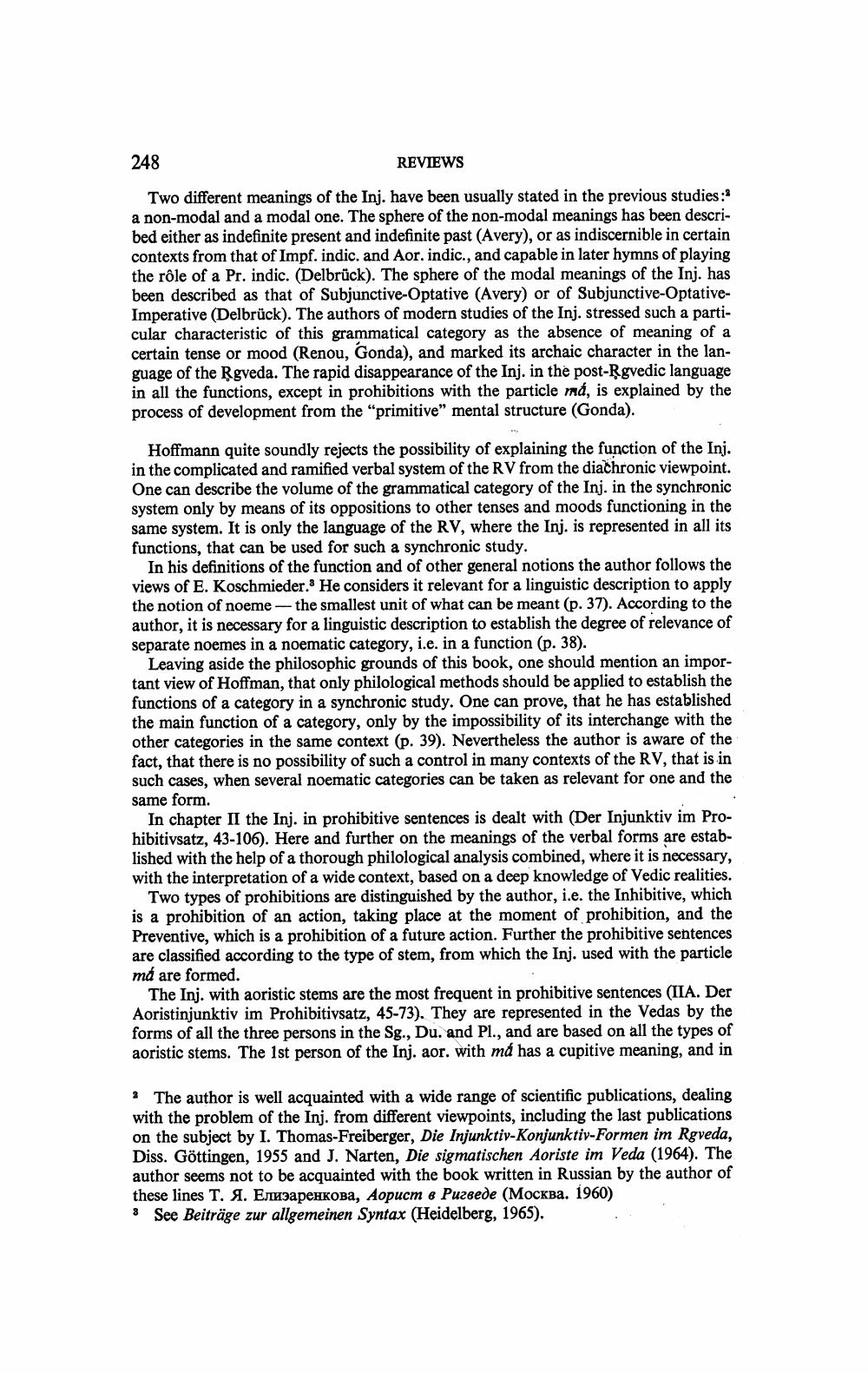Book Title: Reviews Of Different Books Author(s): Publisher: View full book textPage 2
________________ 248 REVIEWS Two different meanings of the Inj. have been usually stated in the previous studies : a non-modal and a modal one. The sphere of the non-modal meanings has been described either as indefinite present and indefinite past (Avery), or as indiscernible in certain contexts from that of Impf. indic. and Aor. indic., and capable in later hymns of playing the role of a Pr. indic. (Delbruck). The sphere of the modal meanings of the Inj. has been described as that of Subjunctive-Optative (Avery) or of Subjunctive-OptativeImperative (Delbruck). The authors of modern studies of the Inj. stressed such a particular characteristic of this grammatical category as the absence of meaning of a certain tense or mood (Renou, Gonda), and marked its archaic character in the language of the Rgveda. The rapid disappearance of the Inj. in the post-Rgvedic language in all the functions, except in prohibitions with the particle ma, is explained by the process of development from the "primitive" mental structure (Gonda). Hoffmann quite soundly rejects the possibility of explaining the function of the Inj. in the complicated and ramified verbal system of the RV from the diachronic viewpoint. One can describe the volume of the grammatical category of the Inj. in the synchronic system only by means of its oppositions to other tenses and moods functioning in the same system. It is only the language of the RV, where the Inj. is represented in all its functions, that can be used for such a synchronic study. In his definitions of the function and of other general notions the author follows the views of E. Koschmieder. He considers it relevant for a linguistic description to apply the notion of noeme -- the smallest unit of what can be meant (p. 37). According to the author, it is necessary for a linguistic description to establish the degree of relevance of separate noemes in a noematic category, i.e. in a function (p. 38). Leaving aside the philosophic grounds of this book, one should mention an important view of Hoffman, that only philological methods should be applied to establish the functions of a category in a synchronic study. One can prove, that he has established the main function of a category, only by the impossibility of its interchange with the other categories in the same context (p. 39). Nevertheless the author is aware of the fact, that there is no possibility of such a control in many contexts of the RV, that is in such cases, when several noematic categories can be taken as relevant for one and the same form. In chapter II the Inj. in prohibitive sentences is dealt with (Der Injunktiv im Prohibitivsatz, 43-106). Here and further on the meanings of the verbal forms are established with the help of a thorough philological analysis combined, where it is necessary, with the interpretation of a wide context, based on a deep knowledge of Vedic realities. Two types of prohibitions are distinguished by the author, i.e. the Inhibitive, which is a prohibition of an action, taking place at the moment of prohibition, and the Preventive, which is a prohibition of a future action. Further the prohibitive sentences are classified according to the type of stem, from which the Inj. used with the particle ma are formed. The Inj. with aoristic stems are the most frequent in prohibitive sentences (IIA. Der Aoristinjunktiv im Prohibitivsatz, 45-73). They are represented in the Vedas by the forms of all the three persons in the Sg., Du. and Pl., and are based on all the types of aoristic stems. The 1st person of the Inj. aor. with ma has a cupitive meaning, and in 2 The author is well acquainted with a wide range of scientific publications, dealing with the problem of the Inj. from different viewpoints, including the last publications on the subject by I. Thomas-Freiberger, Die Injunktiv-Konjunktiv-Formen im Rgveda, Diss. Gottingen, 1955 and J. Narten, Die sigmatischen Aoriste im Veda (1964). The author seems not to be acquainted with the book written in Russian by the author of these lines T. 8. EnugapeHKOBA, Aopucm e Puzbede (Mockba. 1960) 3 See Beitrage zur allgemeinen Syntax (Heidelberg, 1965).Page Navigation
1 2 3 4 5 6 7 8 9 10 11 12 13 14 15 16 17 18 19 20 21 22 ... 48
